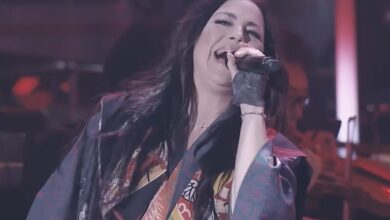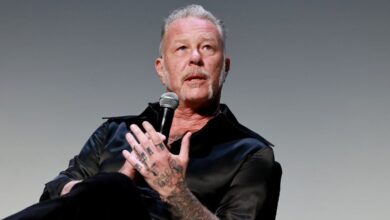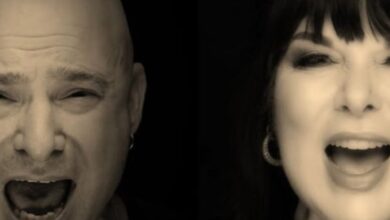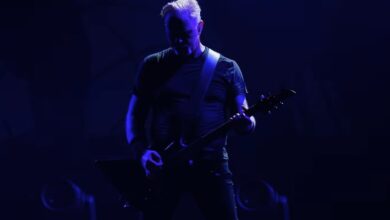Ann Wilson’s “Stairway to Heaven” Performance Leaves Led Zeppelin in Tears
Ann Wilson’s performance of “Stairway to Heaven” at the 2012 Kennedy Center Honors has become one of those rare moments where a cover almost steps outside of time. It was more than a rock tribute; it felt like a carefully staged emotional ambush aimed directly at the three surviving members of Led Zeppelin, at the memory of John Bonham, and at everyone who had ever worn out a copy of Led Zeppelin IV. What people sensed immediately, even before the tears, was that Ann was not simply singing a classic – she was walking into sacred territory with absolute fearlessness and deep respect.
The setup of the night added a pressure cooker level of intensity that most viewers only half realize. This was not a festival or awards-show medley; this was the Kennedy Center Honors, in front of President Barack Obama, Michelle Obama, a hall packed with elite guests, and Jimmy Page, Robert Plant, and John Paul Jones sitting in the balcony in literal spotlight. Ann and Nancy Wilson were handed the job of playing “the untouchable song” in front of the men who wrote it, in a venue more associated with symphonies than screaming guitars. Ann later described the experience as almost overwhelmingly blissful yet razor-sharp, saying she felt every second of it with a kind of awake, physical intensity that bordered on spiritual shock.
What many people don’t realize is how carefully the performance was constructed to disarm Led Zeppelin emotionally rather than simply impress them musically. The first surprise was the choice to begin in almost total restraint. Nancy’s acoustic guitar and Ann’s low, steady vocal keep the first verses intimate and human-scaled, stripping away the bombast that many bar-band versions lean on. That decision was deliberate: the sisters knew that if they went straight for big notes and fireworks, the song would feel like karaoke. Instead, they aimed for something closer to prayer, letting the arrangement slowly gather weight the way the original studio version does, but with added layers of choir and orchestra to mirror the passage of time since the song was first written.
Behind the scenes, there was more anxiety than fans might guess from Ann’s calm demeanor. Nancy has since joked that you cannot play “Stairway to Heaven” with cold fingers in front of Jimmy Page, remembering that the stage itself felt freezing and that the psychological pressure was as physical as the temperature. They had limited rehearsal time with the full orchestra and choir, and the sisters were acutely aware that every guitarist in the world has an opinion about how those arpeggios should sound. Yet they had to balance technical precision with their own identity as Heart – a band that had grown up idolizing Zeppelin but had spent decades forging its own sound. That mix of reverence and self-confidence is part of why the result feels so singular rather than like a textbook recital.
Another rarely discussed detail is how much the staging itself was crafted as a narrative. From the opening camera shot, the audience sees the surviving members of Led Zeppelin in the balcony, wearing their rainbow Kennedy Center medallions, like elders observing a ritual. As Ann begins to sing, the lighting is relatively neutral and the arrangement sparse. With each new section, more elements enter the frame: additional musicians, the string section swelling, the choir slowly filling the back of the stage. By the time the song reaches its final verses, the visual field is crowded with singers in black suits and bowler hats, and Jason Bonham’s drum kit is framed like an altar. Those choices were not random; the bowler hats were a direct, affectionate nod to John Bonham, subtly announcing that his presence was being invoked rather than replaced.
One of the most powerful “hidden” facts about the performance is how Jason Bonham’s appearance was timed as an emotional trigger. Robert Plant reportedly did not know Jason would be part of the arrangement until he walked onstage with the choir, wearing the same kind of hat his father had made iconic. For Plant, whose friendship with John Bonham was one of the defining bonds of his life, that reveal carried a private weight the cameras could only partially capture. Some accounts suggest that his tears were not only for the beauty of the performance, but for the sudden rush of memory – the shock of seeing Bonham’s son anchoring the climax of the song that had followed them like a shadow since the early 1970s.
Ann herself has later described the sensation of singing that night as almost out-of-body. She has said that it felt “orgasmic in terms of bliss,” not in a flippant way, but as a way to explain how intensely alive she felt in those moments – as if every nerve was awake and tied to the emotional core of the song. That isn’t the language of someone simply ticking off notes on a teleprompter. She talked about how the emotional content ran “all the way down to the ground,” emphasizing that she was not acting, not performing grief or awe for the cameras, but genuinely experiencing the song’s spiritual arc in real time. That authenticity is part of why the performance never quite feels like a TV show segment; it feels like a surge of feeling that just happened to be televised.
Less widely known is how long Ann and Nancy had lived with Zeppelin’s music before that night. Heart were not casual fans; in their early days they built much of their live reputation on Zeppelin covers, with Ann tackling Robert Plant’s high-wire vocals in clubs long before MTV or arenas were in the picture. They had spent decades absorbing the phrasing, the spaces between the notes, and the way Zeppelin balanced heaviness with subtlety. By the time the Kennedy Center invitation came, they were among the very few singers on earth who could approach “Stairway to Heaven” without either parody or paralysis. That long apprenticeship allowed Ann to make bold choices – like slightly reshaping certain lines and leaning into her lower register at the start – while still honoring the original melodic architecture.
One of the most striking elements, often overlooked on first viewing, is how Ann treats the famous “and it makes me wonder” line. Instead of trying to mimic Plant’s youthful, almost questioning delivery, she turns it into a mature reflection, stretching the word “wonder” in a way that sounds more like someone looking back over decades rather than forward into the unknown. Because Ann was in her early sixties at the time, the lyric takes on a different shade coming from her – it feels less like a mystical riddle and more like a life audit, sung by someone who has seen career highs, heartbreak, addiction, recovery, and survival. That age shift subtly transforms the song from a young seeker’s quest into an elder’s testimony.
Another subtle but powerful choice is Ann’s control of vibrato and dynamics throughout the performance. On record, she is known for ferocious belts and huge sustained notes, yet here she spends much of the first half of the song holding back, using a narrower vibrato and a more conversational tone. As the arrangement builds, she gradually widens that vibrato and adds more air and grit, so that by the time she hits the climactic “and as we wind on down the road,” her voice is riding the orchestra and choir like a lead guitar. The effect is almost cinematic: you feel the staircase climbing not only in harmony and arrangement, but in the physical texture of her voice.
The presence of the choir itself carries layers of meaning that go beyond simple “epic” decoration. Positioned behind Ann like a wall of witnesses, they turn the song into something communal rather than individual. “Stairway to Heaven” has always been about a kind of spiritual searching, but in this arrangement, the choir’s entrance suggests that the journey is not just one person’s struggle; it is shared by generations of listeners who grew up with the song. When the choir begins echoing lines and singing harmonies under Ann’s lead, it sounds almost like fans around the world finally joining the record they have sung along with in cars and bedrooms for forty years.
There is also a fascinating interplay between Ann and Nancy that tells its own story if you watch closely. Nancy begins seated with the acoustic guitar, focused and almost still, carrying the skeletal framework of the song with her picking. Ann stands as the front-line storyteller, but she frequently turns slightly toward Nancy, as if drawing strength from a partnership that predates fame. When the band and choir enter full force, Nancy shifts from understated accompanist to rock guitarist, adding the crunch and attitude that stop the performance from turning into pure orchestral nostalgia. That sister dynamic – one rooted in shared history, mutual protection, and an almost telepathic musical connection – mirrors the bond between the original members of Led Zeppelin in a way that is emotionally resonant without being literal.
One lesser-talked-about detail is how the performance subtly re-centers female presence within a song and a genre historically dominated by men. Led Zeppelin’s original “lady who’s sure all that glitters is gold” is often read as an archetype or even a cautionary figure. With Ann delivering the lyrics, the female voice becomes the narrator rather than the subject. Combined with Nancy’s crucial role on guitar and the women in the choir, the tribute presents “Stairway to Heaven” as a story told and embodied by women without ever turning it into a didactic statement. It is a quiet inversion, but part of what makes the cover feel fresh rather than museum-like.
In the years since that night, Ann has been open about how the performance followed her as a kind of defining moment. She has said that she did not fully grasp, in the moment, how emotionally wrecked Robert Plant was until she later saw the footage of him wiping his eyes and looking stunned. For her, the focus was on staying grounded in the song, staying in tune with the orchestra, and letting whatever needed to happen, happen. Only afterward did she realize that the tribute had become, for many fans, the definitive example of how to cover a rock classic without diminishing it – a case study in how to bring your full self to someone else’s masterpiece.
Another interesting angle is how that single performance shifted the broader conversation about tribute shows and award-show covers. Before this, it was common for such segments to feel like spectacle – star-studded medleys, mashups, flashy cameos – more about buzz than depth. Heart’s “Stairway” raised the bar by showing that a tribute could be reverent, risky, and emotionally devastating all at once. It reminded viewers that when you give great artists enough space and trust, they can create something that stands beside the original rather than clinging to it. Many later tributes, from other genres and for other artists, have been measured against the emotional standard set in that seven-minute performance.
Finally, what makes Ann Wilson’s “Stairway to Heaven” so endlessly rewatchable is the sense that something unrepeatable happened that night – a convergence of history, personal memory, and live-wire performance. Led Zeppelin were being honored not just as rock stars but as cultural architects. Jason Bonham was carrying his father’s ghost into the room. Ann and Nancy Wilson were returning, in a way, to the music that had formed them as young musicians, only now with decades of scars and triumphs in their voices and hands. The result is that rare musical event that feels both meticulously prepared and wildly alive, a reminder that even the most overplayed song in rock history can still reveal new emotional depths in the right hands.





